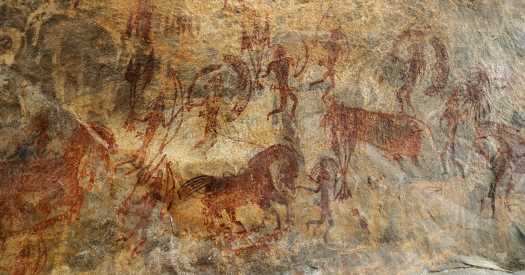
Ten thousand years ago or more, people started painting the walls of caves near Bhopal, India. Over the millenniums they made thousands of images in what are now called the Bhimbetka Rock Shelters: men, women, a couple having sex, dancers, children, hunts, battles, about 29 different animal species and mythical beasts like a part-boar part-ox part-elephant.
Over time, art styles shifted. Human figures donned clothes. Horses and elephants sprouted riders. Wars danced across sandstone faces. Today, many of the cave walls are now palimpsests, with medieval warriors covering Chalcolithic art on top of even older Mesolithic drawings.
Still, an overlooked pattern spotted by a tour group of scientists in March 2020 seemed so, so, so much older. Older than representational art or humans or primates or fish or horseshoe crabs. Eleven feet up on the wall of an area called Auditorium Cave, the visitors had identified something that looked an awful lot like an imprint of Dickinsonia, an iconic 550 million year-old fossil from the first bloom of complex life on Earth.
The gaggle of geologists had traveled to India for last spring’s International Geological Congress, which was then canceled because of the pandemic. But the pre-conference field trips went ahead, including a visit to the caves led by Ranjit Khangar and Merajuddin Khan from the Geological Survey of India.
“Talk about serendipity,” said Gregory Retallack, a paleontologist at the University of Oregon who described the 17-inch fossil this month in the journal Gondwana Research. “Finding it where we would not expect, on the last day of the expedition, in a cultural stop?”
Dr. Retallack and the others didn’t have hammers or equipment on them. Instead they took as many different pictures from as many different angles as possible. Back home after the trip, they used image-based 3-D modeling software to take a closer look.
Dickinsonia, a blob with internal ridges that looks vaguely like a halved Christmas ham, has been found in Australia, Russia, Ukraine and as of this January, close to China’s Three Gorges Dam. No Indian specimens were known. But the size, shape and surrounding rocks of the Bhimbetka pattern all match Dickinsonia fossils elsewhere, the team argues, confirming the find.
Within Indian geology, the discovery may settle a long debate about the ages of ancient basins like the one that hosts the Bhimbetka site. Some studies date these rocks to 800 or 900 million years ago; others have suggested they are younger. Fossils, tied to specific ages like footnotes on the pages of a book, could help.
“People have been trying for decades to look at the fossil content of these rocks, and they haven’t come up with much convincing evidence,” said Suvrat Kher, a science writer in Pune, India. The presence of Dickinsonia, however, nails down an age of about 550 million years.
Other scientists note that Dr. Retallack is embroiled in a deep debate over where Dickinsonia and other bizarre early organisms fit on the tree of life.
Recent scientific consensus has shifted toward calling them prototypical animals that lived on the seafloor. But Dr. Retallack’s work has held that these organisms — including this one — lived on land, not in the sea, and that they were lichens.
But his critics make an exception for this finding.
“Most of Greg’s work, there’s a million reasons why it’s wrong,” said Emily Mitchell, a paleontologist at the University of Cambridge. “This, to me, it’s feasible. And if it was it would be very very cool.”
The discovery might really be Dickinsonia, she said. One way to further examine that might be to get permission to scrape off and test a little material. But given where it was found, she said, it also could be a painting or petroglyph itself, a possibility rejected in Dr. Retallack’s study.
If it is just cave art, it could merely be a satisfying, simple design that only looks like Dickinsonia to paleontologists with that fossil already on the mind. Or to add confusion: it could even be an ancient rendering of a Dickinsonia.
So maybe it’s a drawing that happens to look like a fossil, or a drawing about a fossil, or maybe it’s the real deal: a trace from the dawn of life nearly overwritten by the dawn of human creativity.
In that latter case, “I think wow, they can’t have failed to notice it,” said Dr. Retallack, speculating about the cave artists. “I wonder if that was why they decided to decorate the cave?”
Source: Read Full Article
